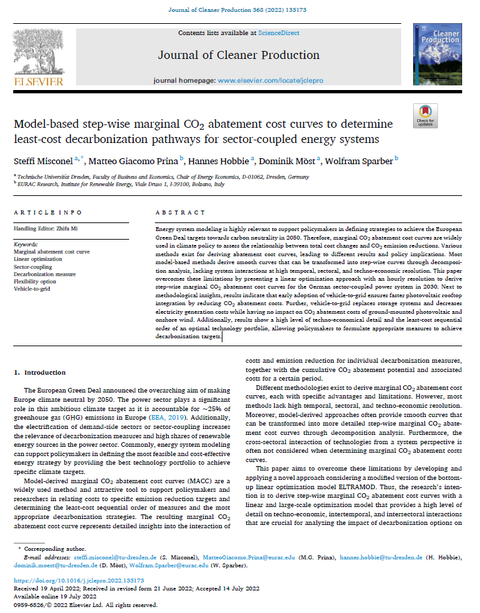08.08.2022
Neue Veröffentlichung “Model-based step-wise marginal CO2 abatement cost curves to determine least-cost decarbonization pathways for sector-coupled energy systems”
We are thrilled to share our research on the topic “Model-based step-wise marginal CO2 abatement cost curves to determine least-cost decarbonization pathways for sector-coupled energy systems”.
The article was published in Journal of Cleaner Production and can be downloaded for free for 50 days: https://authors.elsevier.com/a/1fXXL3QCo9fCjV
A big thanks goes to all authors Steffi Misconel, Matteo Giacomo Prina, Hannes Hobbie, Wolfram Sparber and Dominik Möst.
The study was conducted as part of a research exchange and cooperation on energy system modeling of decarbonization pathways between the Institute for Renewable Energy at the EURAC Research Center (Bolzano, Italy) and the Chair of Energy Economics at TU Dresden.
Highlights of the paper
- A linear optimization model derives step-wise marginal CO2 abatement cost curves.
- Results show interdependencies and substitution effects of decarbonization measures.
- Hourly sector-coupling analysis is performed for the German energy system in 2030.
- Early VtG adoption ensures PV rooftop integration by reducing CO2 abatement costs.
- VtG replaces storage and decreases short-term electricity generation costs.
Summary
Energy system modeling is highly relevant to support policymakers in defining strategies to achieve the European Green Deal targets towards carbon neutrality in 2050. Therefore, marginal CO2 abatement cost curves are widely used in climate policy to assess the relationship between total cost changes and CO2 emission reductions. Various methods exist for deriving abatement cost curves, leading to different results and policy implications. Most model-based methods derive smooth curves that can be transformed into step-wise curves through decomposition analysis, lacking system interactions at high temporal, sectoral, and techno-economic resolution. This paper overcomes these limitations by presenting a linear optimization approach with an hourly resolution to derive step-wise marginal CO2 abatement cost curves for the German sector-coupled power system in 2030. Next to methodological insights, results indicate that early adoption of vehicle-to-grid ensures faster photovoltaic rooftop integration by reducing CO2 abatement costs. Further, vehicle-to-grid replaces storage systems and decreases electricity generation costs while having no impact on CO2 abatement costs of ground-mounted photovoltaic and onshore wind. Additionally, results show a high level of techno-economical detail and the least-cost sequential order of an optimal technology portfolio, allowing policymakers to formulate appropriate measures to achieve decarbonization targets.
We hope you enjoy reading this!

